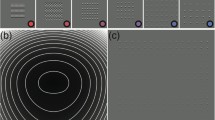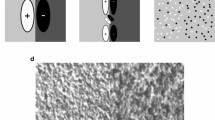Abstract.
This article presents a computational model of early visual information processing that attempts to account for the central performance drop (CPD) in texture segmentation. CPD is the finding that detection performance on short stimulus displays of line textures using orientation differences to set off the target is not maximal at the foveal center but in parafoveal areas. A comparison between a simulation and psychophysical experimental data supported the assumption that the CPD may be explained by properties of spatial frequency channels whose band-pass filter characteristics are not constant over the retina but differ with eccentricity in a defined manner. The model provided satisfactory predictions of experimental data based on densely or widely spaced line elements in texture fields. It is concluded that preattentive texture analysis might be performed by a relatively small number of simple spatial filters.
Similar content being viewed by others
Author information
Authors and Affiliations
Additional information
Received: 14 November 1996 / Accepted in revised form: 3 June 1997
Rights and permissions
About this article
Cite this article
Kehrer, L. The central performance drop in texture segmentation: a simulation based on a spatial filter model. Biol Cybern 77, 297–305 (1997). https://doi.org/10.1007/s004220050391
Issue Date:
DOI: https://doi.org/10.1007/s004220050391




